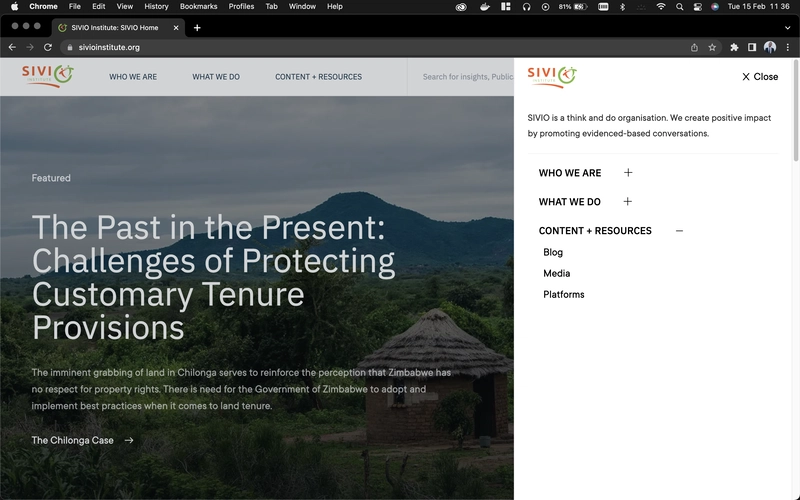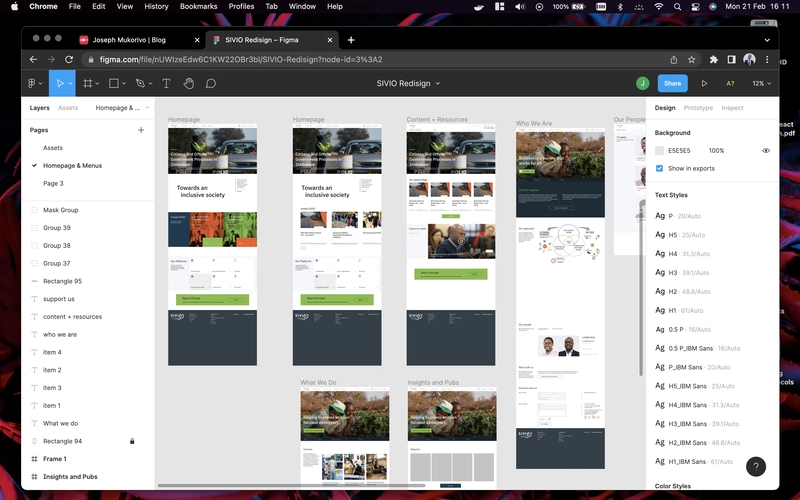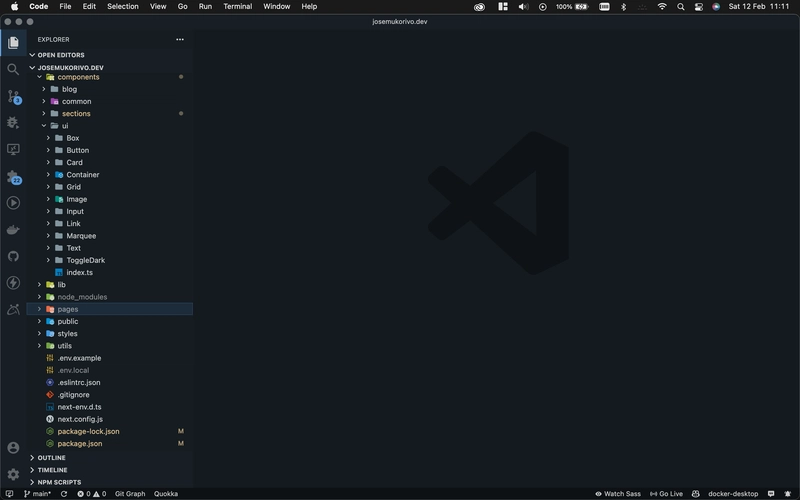我如何开发现代 JAMStack 网站
概述
2021年,我开始为一家我2020年就职的公司进行品牌重塑项目。这是项目链接。这家公司已经有了一个不错的网站,但他们从2018年就开始使用这个网站了,他们想要一个新颖、现代,并且非开发人员也能轻松管理的网站。为了这个项目取得成功,我和一位设计师朋友合作。我们坐下来开始规划如何进行,因为即使是公司网站,它也包含很多活动部分,所以需要一些规划。
Figma 设计
主页设计

我和朋友之前都有一些使用 Scrum 进行项目管理的经验,所以决定在这个项目中使用 Scrum,因为它很合适。我们开始创建产品待办事项列表,确定功能的优先级,并将工作划分为多个冲刺。我们与产品负责人密切合作,以确保我们开发的是用户真正想要的东西。
技术栈选择
这是项目开发过程中一个有趣的阶段。出于多种原因,我们决定在项目中使用 JAMStack。项目设计使用figma完成,然后我开始使用React进行 UI 开发。我决定使用tailwind css进行样式设置,因为它可以非常快速地设置组件样式。我不喜欢在标记中使用一堆类,所以我使用了 tailwind 和 css 模块(我将展示部分代码片段)。因为我们希望这个网站性能良好且 SEO 友好,所以我决定使用NextJS(作者称其为用于生产的 React 框架,他们说得对)。NextJS 具有许多开箱即用的性能和 SEO 功能,例如服务器端渲染、代码拆分、图像优化、路由等等。在这个项目中,为后端启动自定义 API 是没有意义的,所以我决定使用一个现代 CMS,在本例中是strapi。这个网站上的所有后端内容都来自 strapi。
我还使用了许多其他工具,但我不会详细介绍它们。下面我将总结一下我使用的关键工具。
项目中使用的关键内容
React用于 UI
NextJS用于 SSR/CSR/Routing 等
Tailwindcss用于 UI 样式
Strapi作为 CMS
Docker用于应用程序容器化
nginx作为 Web 服务器和反向代理
git用于版本控制
mailchimp用于管理邮件列表
项目结构
项目结构方面,我沿用了这个结构,并进行了一些改进,但作为起点还是不错的。以下是总体概述。
创建组件
我尝试使我开发的组件可重复使用,下面是该Text组件的示例文件。
文本.css
.root {
@apply mb-4;
}
.root:is(h1, h2, h3, h4, h5, h6) {
@apply mb-7 2xl:mb-10 leading-tight dark:text-slate-200;
}
.p {
@apply text-lg 2xl:text-xl;
}
.span {
@apply text-lg;
}
.h1 {
@apply text-4xl md:text-5xl font-heading font-medium uppercase;
}
.h2 {
@apply text-2xl md:text-4xl font-heading uppercase;
}
.h3 {
@apply text-3xl;
}
.h4 {
@apply text-2xl;
}
.h5 {
@apply text-xl;
}
.h6 {
@apply text-lg;
}
文本.tsx
import { FC, CSSProperties, ReactNode } from 'react';
import cn from 'classnames';
import s from './Text.module.scss';
type Variant = 'h1' | 'h2' | 'h3' | 'h4' | 'h5' | 'h6' | 'p' | 'span';
interface Props {
as?: Variant;
className?: string;
style?: CSSProperties;
children?: ReactNode | any;
html?: string;
}
export const Text: FC<Props> = ({
as: Tag = 'p',
className = '',
style = {},
children,
html,
...rest
}) => {
const classes = cn(
s.root,
{
[s.p]: Tag === 'p',
[s.span]: Tag === 'span',
[s.h1]: Tag === 'h1',
[s.h2]: Tag === 'h2',
[s.h3]: Tag === 'h3',
[s.h4]: Tag === 'h4',
[s.h5]: Tag === 'h5',
[s.h6]: Tag === 'h6',
},
className // make sure to add the className last so it overwrites the other classes
);
const htmlProps = html
? {
dangerouslySetInnerHTML: { __html: html },
}
: {};
return (
<Tag className={classes} {...rest} {...htmlProps}>
{children}
</Tag>
);
};
示例用法
<Text as='h1'>
Hi 👋🏼, I’m Joseph. Writer, Software Engineer, DevOps
</Text>
<Text className='cool'>
This is a sample paragraph
</Text>
托管和部署
我为这家公司开发了这个网站,这家公司规模不大,也没有庞大的技术团队,所以我使用了我认为其他人维护起来比较方便的工具。Strapi 使用 Docker 容器运行docker-compose,前端也以类似的方式运行。在 Strati 和前端的源代码中,我创建了一些Make文件来运行项目。下面是一个示例 Makefile。
down:
docker-compose down
build:
docker-compose up -d --build
redeploy:
git pull && make down && make build
在这种情况下,如果源代码有变化,用户不需要知道如何使用 docker,他们只需make redeploy在项目的根目录中运行,所有代码提取和图像构建都为他们完成,当然这在README.
这些服务在服务器上的不同端口上运行,我使用 将它们暴露出来nginx。以下是如何为 strapi 配置 nginx 文件。请注意,在生产环境中,您必须确保以安全的方式进行配置,这只是为了帮助您入门。
server {
server_name example.com www.example.com;
location / {
keepalive_timeout 64;
proxy_pass http://localhost:8080; # use your local port where strapi is running
proxy_http_version 1.1;
proxy_set_header X-Forwarded-Host $host;
proxy_set_header X-Forwarded-Server $host;
proxy_set_header X-NginX-Proxy true;
proxy_set_header X-Real-IP $remote_addr;
proxy_set_header X-Forwarded-For $proxy_add_x_forwarded_for;
proxy_set_header X-Forwarded-Proto $scheme;
proxy_set_header Host $http_host;
proxy_set_header Upgrade $http_upgrade;
proxy_set_header Connection "upgrade";
proxy_pass_request_headers on;
proxy_max_temp_file_size 0;
proxy_redirect off;
proxy_read_timeout 240s;
}
listen 443 ssl; # managed by Certbot
ssl_certificate /etc/letsencrypt/live/example.com/fullchain.pem; # managed by Certbot
ssl_certificate_key /etc/letsencrypt/live/example.com/privkey.pem; # managed by Certbot
include /etc/letsencrypt/options-ssl-nginx.conf; # managed by Certbot
ssl_dhparam /etc/letsencrypt/ssl-dhparams.pem; # managed by Certbot
}
server {
if ($host = www.example.com) {
return 301 https://$host$request_uri;
} # managed by Certbot
if ($host = example.com) {
return 301 https://$host$request_uri;
} # managed by Certbot
server_name example.com www.example.com;
listen 80;
return 404; # managed by Certbot
}
希望本文对你有所帮助。PS:你可以在Twitter上关注我。
文章来源:https://dev.to/josemukorivo/how-i-development-a-modern-jamstack-website-3heo 后端开发教程 - Java、Spring Boot 实战 - msg200.com
后端开发教程 - Java、Spring Boot 实战 - msg200.com

